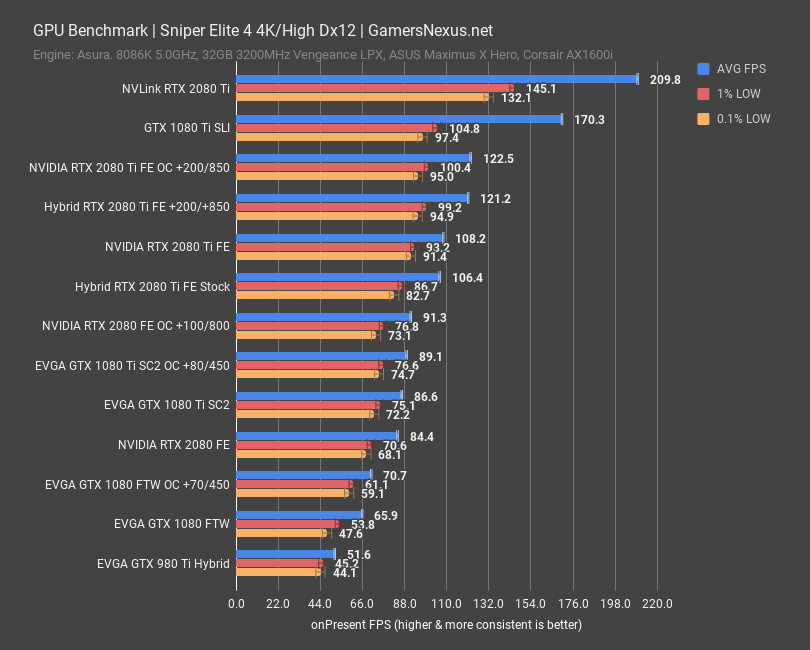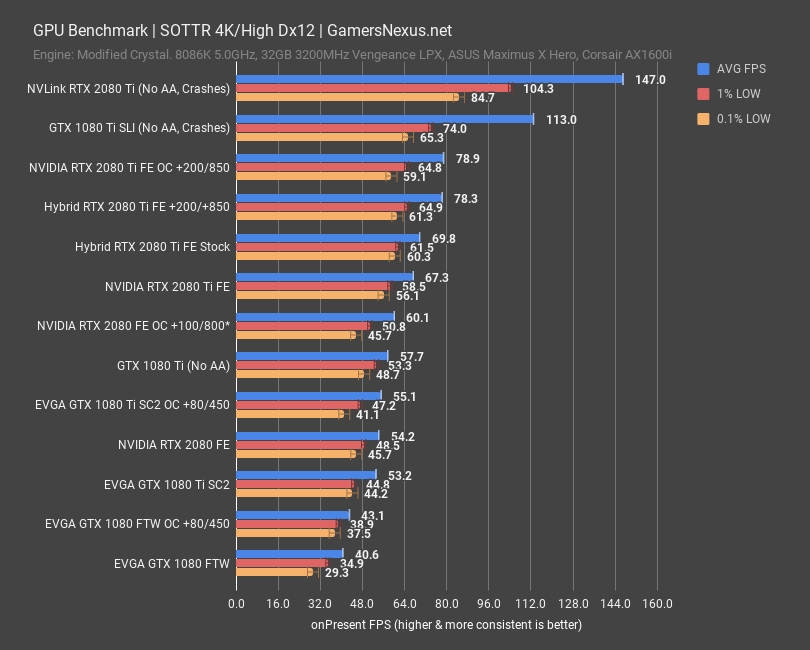We always like to modify the reference cards – or “Founders Edition,” by nVidia’s new naming – to determine to what extent a cooler might be holding it back. In this instance, we suspected that the power limitations may be a harder limit than cooling, which is rather sad, as the power delivery on nVidia’s RTX 2080 Ti reference board is world-class.
We recently published a video showing the process, step-by-step, for disassembling the Founders Edition cards (in preparation for water blocks). Following this, we posted another piece wherein we built-up a “Hybrid” cooling version of the card, using a mix of high-RPM fans and a be quiet! Silent Loop 280 CLC for cooling the GPU core on a 2080 Ti FE card. Today, we’re summarizing the results of the mod.
Test Methodology
Testing methodology has completely changed from our last GPU reviews, which were probably for the GTX 1070 Ti series cards. Most notably, we have overhauled the host test bench and had updated with new games. Our games selection is a careful one: Time is finite, and having analyzed our previous testing methodologies, we identified shortcomings where we were ultimately wasting time by testing too many games that didn’t provide meaningfully different data from our other tested titles. In order to better optimize our time available and test “smarter” (rather than “more,” which was one of our previous goals), we have selected games based upon the following criteria:
- Game Engine: Most games run on the same group of popular engines. By choosing one game from each major engine (e.g. Unreal Engine), we can ensure that we are representing a wide sweep of games that just use the built-in engine-level optimizations
- API: We have chosen a select group of DirectX 11 and DirectX 12 API integrations, as these are the most prevalent at this time. We will include more Vulkan API testing as more games ship with Vulkan
- Popularity: Is it something people actually play?
- Longevity: Regardless of popularity, how long can we reasonably expect that a game will go without updates? Updating games can hurt comparative data from past tests, which impacts our ability to cross-compare new data and old, as old data may no longer be comparable post-patch
Game graphics settings are defined in their respective charts.
We are also testing most games at all three popular resolutions – at least, we are for the high-end. This includes 4K, 1440p, and 1080p, which allows us to determine GPU scalability across multiple monitor types. More importantly, this allows us to start pinpointing the reason for performance uplift, rather than just saying there is performance uplift. If we know that performance boosts harder at 4K than 1080p, we might be able to call this indicative of a ROPs advantage, for instance. Understanding why performance behaves the way it does is critical for future expansion of our own knowledge, and thus prepares our content for smarter analysis in the future.
For the test bench proper, we are now using the following components:
GPU Test Bench (Sponsored by Corsair)
Component | Courtesy of | |
CPU | GamersNexus | |
GPU | This is what we’re testing! | Often the company that makes the card, but sometimes us (see article) |
Motherboard | ASUS | |
RAM | Corsair | |
PSU | Corsair | |
Cooler | NZXT | |
SSD | Plextor 256-M7VC | GamersNexus |
Separately, for the initial RTX 20-series reviews, we are using 10-series board partner models instead of reference models. This is because we know that most of the market, for fact, is using board partner models, and we believe this to be the most realistically representative and relatable for our audience. We acknowledge that the differences between the RTX and GTX reference cards would be more pronounced than when comparing partner cards, but much of this is resultant of poor cooler and reference card solutions in the previous generation. It creates, in our eyes, an unrealistically strong appearance for incoming cards on dual-axial coolers, and does not help the vast majority of users who own board partner model 10-series cards.
Clock Scaling: RTX 2080 Ti Hybrid Liquid Cooling vs. Air Cooling
Starting strictly with frequency will help best illustrate the performance characteristics of our Hybrid mod. We’ll get to thermals momentarily. For this test, we’re using 3DMark – Firestrike Extreme on a frozen frame to render the same data repeatedly.
Overclock Scaling on RTX 2080 Ti with Water Cooling
Before those, here’s what it looks like when we add an overclocked line to the chart. We were able to sustain a highly stable 2130MHz clock once we found stability – you’ll see a few crashes in there from when we were finding the limits. The all-time peak was 2175MHz, then we stabilized for a little while at 2145MHz, but the application crashed shortly after. A firm stable frequency of 2130MHz was possible in Firestrike with the new cooling solution. That’s a major jump over the air-cooled card, but whether or not it gets leveraged in games will heavily lean on when the power limits are encountered.
GPU, VRM, and VRAM Temperature Differences
Let’s look next at the same tests as the previous two charts, except this time from the perspective of thermal results on the GPU diode only. We can look at VRM and VRAM temperatures next.
Note that, for this chart, we heavily controlled ambient temperature and monitored it every second. Data is presented with a constant ambient temperature. The air-cooled card sits at a near-constant 75 degrees Celsius, +/- 2 degrees. The Hybrid managed a 42-degree constant temperature, with occasional fluctuations +/- 2 degrees. The overclocked variant pushed to 45 degrees, but stopped there.
For individual component temperatures, we saw the GPU core drop to 18 degrees delta T over ambient – again, that’s over ambient, which was about 22C during testing. The VRM temperature for our hybrid mod was 60.8 degrees over ambient, with the memory temperature at 40.8 degrees over ambient. These temperatures were achieved entirely with a ton of air cooling. We had 2 fans pointed directly at the VRM and VRAM during this test, illustrating that heatsinks are actually not necessary with sufficient airflow. We’d still advise heatsinks, especially inside of a case, but they are not wholly necessary in the right environment. The stock, air-cooled card averaged a 52 degree over ambient core temperature and 50 degree VRM temperature, also over ambient, with memory at 58C over ambient.
[game test methodology]
F1 2018 – RTX 2080 Ti Hybrid Benchmark
F1 2018 is up now. This game uses the Codemasters EGO engine and is useful for a heavily GPU-intensive title. It’s also our only racing game representation.
Just in case you were wondering, 1440p is the same situation: The Hybrid mod pushes about 4% faster framerate than the 2080 Ti FE. Not impressive for the amount of work involved, and ultimately a power limitation. Once again, we’re pegged to 15A down the PCIe cables.
Sniper Elite 4 – RTX 2080 Ti Hybrid Benchmark
We recently praised Sniper Elite 4 for its impressive scalability from the team’s in-house Asura engine and proper DirectX 12 implementation. Unfortunately, it also posts zero meaningful scaling, showing hard power limits and killing all hope for thermal differences triggering meaningful clock boosts that impact performance.
Far Cry 5 – RTX 2080 Ti Hybrid Benchmark
Far Cry 5 uses the Dunia engine and is commonly GPU bottlenecked, particularly at higher resolutions. The game is also running as a representation of a Dx11 title. At 4K, the RTX 2080 Ti FE operates at 74FPS AVG, with the Hybrid mod at 76FPS AVG. We see zero scaling when both are overclocked to +200MHz core and +850MHz memory – the scaling has vanished as we’ve bumped against a hard power limit.
1440p posts the same thing: We’re hitting power limits more than thermal limits, despite the stock Hybrid card outperforming the stock air-cooled card by 2.7%. Overclocking both ends up fully limited by power.
Shadow of the Tomb Raider – RTX 2080 Ti Hybrid Benchmark
Shadow of the Tomb Raider is the last one we’ll bother showing. This is a modified Crystal Engine game on Dx12. We have other games benchmarked as well, like GTA and Ashes, but the results scaling is identical to what we’re seeing in these others. It’d be boring to show 20 minutes of charts that are power limited; suffice to say, the Hybrid mod only helps marginally for this generation’s reference card. We simply need more power.
As for Tomb Raider, at 4K, the numbers are nearly identical for both the stock Hybrid and air-cooled cards and the overclocked variants. No meaningful change from thermal advantage.
Conclusion: Is Liquid Cooling an RTX 2080 Ti Worth It?
The answer to the above header is "no, not really."
Unfortunately, for the first time in our history of hybrid-modding cards, there's really no immediate benefit. It's cooler, sure, and that does help with clocks -- but most games have us slammed against a power limitation, hitting 15A down the PCIe cables and proceeding no further. NVidia, for having the best VRM and PCB they've made in their history of consumer cards, has for some reason heavily limited the power throughput allowance on the Turing cards. It's sad, really, as the board can handle the power and our cooling solution can handle the heat. It may be true that nVidia found its GPU to be prone to failure at higher voltages or power throughput, but we'd still like to have the option to expose it to said failure if we so choose. That is, after all, the enthusiast way.
Regardless, the only real reason to liquid cool these cards is to reduce noise. That's a fine reason, but not the one we wanted.
Onwards and upwards with a less power limited board, it seems, would be our only option to increase the clocks further.
Editorial, Testing: Steve Burke
Video: Andrew Coleman











